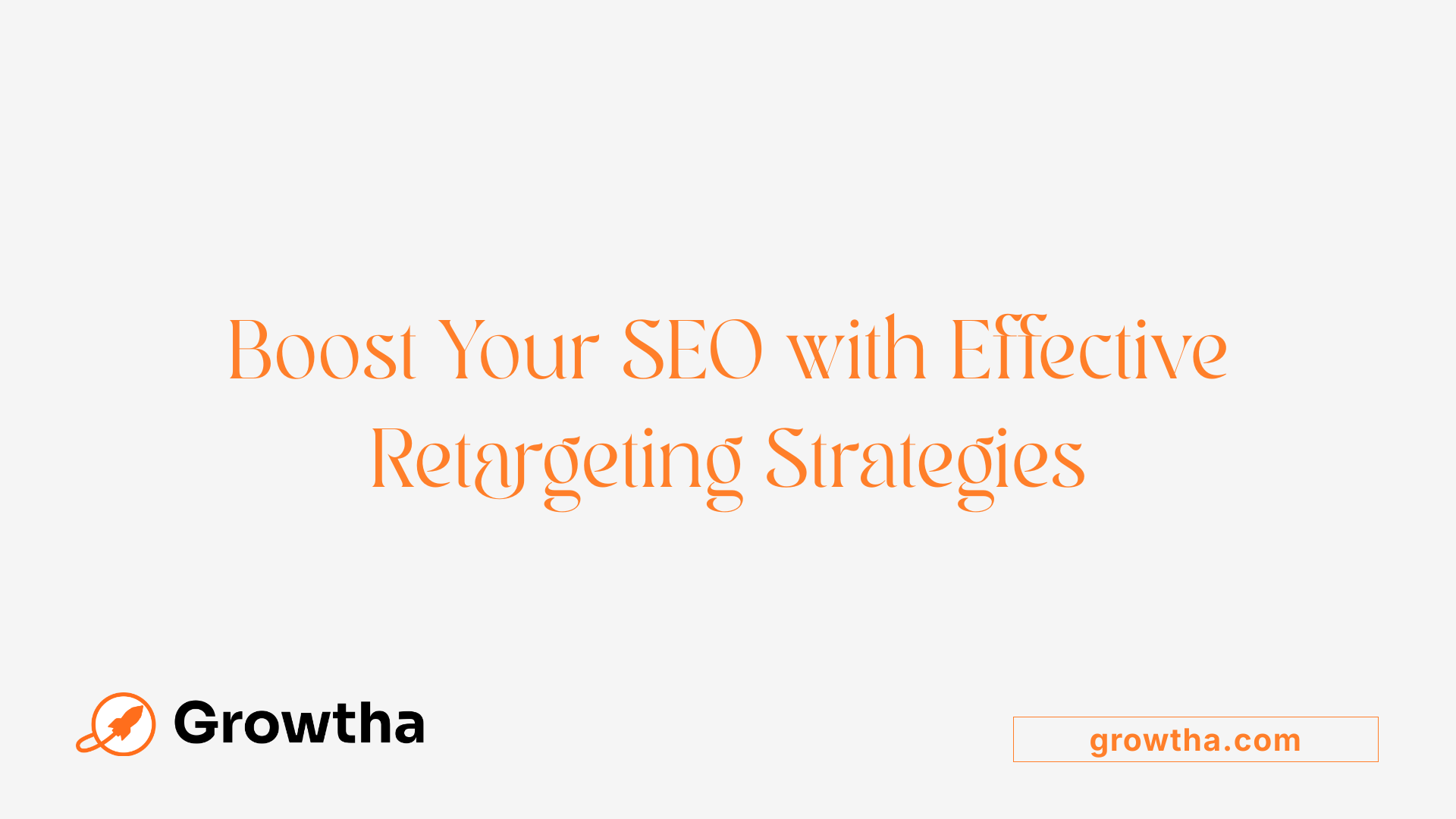How to Use Retargeting Ads to Support SEO Goals
Enhancing Search Strategies with Smart Retargeting Tactics


How to Use Retargeting Ads to Support SEO Goals
Harnessing Retargeting for Better SEO Performance
In today’s digital landscape, businesses constantly seek innovative ways to improve their search engine rankings and online visibility. While SEO lays the groundwork by increasing organic traffic, retargeting ads serve as a powerful complement by re-engaging visitors and reinforcing brand presence across multiple platforms. This article explores how strategic use of retargeting advertising can support and amplify SEO goals, creating an integrated approach that drives both immediate conversions and sustained organic growth.
Understanding Retargeting and Its Impact on SEO

What is retargeting and remarketing?
Retargeting, often called remarketing, is a digital marketing approach that displays ads to people who have previously interacted with a website or brand but have not completed a desired action, such as making a purchase. This strategy helps re-engage potential customers by reminding them of products or services they viewed, increasing the chances of conversion.
Remarketing usually involves serving ads through various platforms, including display networks, social media, and search engines. The goal is to keep the brand top-of-mind among users who are already familiar with it, thus moving them further along the customer journey.
How do cookies and tracking pixels facilitate retargeting?
Cookies and tracking pixels are essential tools for retargeting. Cookies are tiny data files stored in a user’s browser that contain information about their online behavior. When a visitor loads a website with retargeting scripts, a small piece of code called a pixel or tag is embedded.
This pixel tracks actions like page views, products viewed, or specific interactions. If a user leaves the site without purchasing, the pixel records this behavior. Later, across other platforms such as social media and display networks, targeted ads are served to these users, reminding and persuading them to return.
How can retargeting support and enhance SEO efforts?
Retargeting plays a supportive role in SEO by boosting overall brand visibility and recognition. When users see targeted ads repeatedly, they develop stronger brand recall, which encourages repeat visits—an essential factor for organic search rankings.
Additionally, retargeting increases website traffic from high-intent users, improving engagement metrics like dwell time and bounce rate, which search engines consider in their algorithms. It also fosters a cohesive online presence across diverse channels, making the brand more memorable. As a result, the combined effect of retargeting and SEO can lead to higher organic search interest, more branded searches, and better positioning in search engine results pages.
How can businesses combine retargeting with SEO campaigns?
Integrating retargeting with SEO involves aligning messaging and keywords across platforms. Marketers can synchronize SEO-focused keywords with retargeting ads, ensuring consistency. Using SEO data such as search intent and keyword performance helps craft more relevant retargeting content.
Implementing search retargeting—showing ads to users based on their search queries—even if they haven't visited the website, broadens reach. Sharing audience insights from SEO efforts via analytics reveals which segments are most valuable for targeted campaigns.
Moreover, developing customized audiences based on behaviors and interests enhances personalization, improving chances of conversions. Combining these tactics maximizes both paid and organic visibility, supporting the overall digital marketing strategy.
Which metrics are vital for assessing retargeting's impact on SEO?
Tracking performance through specific metrics is essential. Important indicators include:
| Metric | Explanation | Why It Matters |
|---|---|---|
| Website Traffic | Number of visitors from retargeted ads | Shows the effectiveness in increasing return visits |
| Click-Through Rate (CTR) | Percentage of viewers clicking ads | Reflects ad relevance and engagement |
| Conversion Rate | Percentage of visitors completing actions | Measures success in driving goals like purchases or sign-ups |
| Bounce Rate | Visitors leaving after viewing one page | Lower bounce indicates higher engagement |
| Return on Ad Spend (ROAS) | Revenue generated per ad dollar spent | Indicates profitability |
| Organic Traffic Changes | Shifts in SEO-driven visits | Demonstrates SEO support effectiveness |
Consistent monitoring of these metrics allows marketers to optimize campaigns and strengthen the relationship between retargeting efforts and SEO outcomes.
Why combine retargeting and SEO strategies?
Merging retargeting with SEO amplifies brand exposure across multiple channels. This approach not only encourages immediate conversions but also builds a sustainable presence online.
Retargeting reinforces organic SEO by prompting repeat visits, improving user engagement metrics, and fostering trust. When combined with keyword-optimized content, it leads to a cohesive brand message.
Furthermore, this synergy helps capture high-value users earlier in their purchasing journey, ensuring consistent visibility and increased chances of conversion. Overall, blending these strategies creates a resilient marketing ecosystem that supports short-term goals and long-term growth.
How do retargeting ads enhance search engine visibility and site engagement?
Retargeting ads reintroduce interested users to the website by displaying personalized messages related to their previous interactions. This constant reminder encourages users to return, increasing the likelihood of conversion.
These ads can be based on search behavior, viewed pages, or shopping carts, which helps deliver highly relevant content. They also promote ongoing engagement, which can positively affect organic search rankings by increasing time on site and interaction rate.
Integrating retargeting with social media, SEO, and content marketing creates a cohesive marketing environment, extending the brand's reach and improving overall online engagement.
What best practices should be followed to align retargeting with SEO objectives?
To align retargeting with SEO, marketers should:
- Segment audiences based on behavior, location, and interests to target relevant groups.
- Synchronize ad messaging with organic content and keywords for message consistency.
- Use compelling creative and offers that motivate user actions.
- Limit ad frequency to prevent ad fatigue, using caps or time windows.
- Leverage data from SEO tools to refine audience targeting and personalize ads.
- Regularly review performance metrics to adjust campaigns and optimize results.
- Ensure privacy compliance by following laws such as GDPR and CCPA.
Applying these best practices ensures that retargeting efforts support SEO goals effectively, leading to higher engagement and better search rankings.
How does retargeting complement broader digital marketing efforts?
Retargeting synergizes with other marketing channels by guiding users through the sales funnel, fostering deeper brand familiarity.
While SEO builds organic visibility, retargeting captures those visitors who have already expressed interest. Combining the two increases the chances of conversions and improves campaign ROI.
Additionally, retargeting provides valuable data that can inform content marketing, email nurturing, and social campaigns. It ensures that messaging remains consistent and relevant, creating a comprehensive digital strategy that elevates overall brand presence.
This integrated approach strengthens the entire marketing ecosystem, aligning short-term performance with long-term growth goals.
Best Practices for Retargeting to Amplify SEO Results

What are the best practices for using retargeting ads to achieve SEO objectives?
To effectively leverage retargeting ads for SEO, marketers should focus on meticulous audience segmentation. This involves categorizing visitors based on their behavior, purchase intent, geographic location, and engagement levels. Such segmentation allows for crafting personalized messages that resonate, boosting relevance and response rates.
Ad campaigns should incorporate clear and compelling calls to action (CTAs), aligned with the content users previously engaged with. Adding offers like discounts or incentives can further motivate conversions and foster brand loyalty.
Managing ad frequency is critical; implementing frequency caps prevents ad fatigue, ensuring users aren’t overwhelmed and maintain a positive view of your brand. Dynamic ad formats and creative visuals keep campaigns fresh, engaging, and less intrusive.
Integrate your SEO and analytics data to inform audience targeting, creating custom audiences and lookalikes that mirror your high-value visitors. Adjust bids and campaign durations according to your sales cycle to maximize impact.
Regularly monitor key performance metrics such as click-through rate (CTR), conversion rate, and return on ad spend (ROAS). This data facilitates ongoing optimization of creative content, timing, and targeting strategies.
Employ cross-channel retargeting—running ads across platforms like Google, Facebook, LinkedIn, and even Connected TV—to create a cohesive brand presence.
This comprehensive approach ensures that retargeting efforts support SEO goals by attracting quality traffic, increasing engagement, and encouraging repeat visits, ultimately reinforcing organic search efforts and improving rankings.
Strategic Integration for Long-Term Digital Success
In conclusion, the strategic use of retargeting ads plays a crucial role in supporting and boosting SEO objectives. When integrated thoughtfully with organic strategies, retargeting not only increases brand visibility and engagement but also signals relevance and popularity to search engines. Marketers should focus on audience segmentation, dynamic ad personalization, and continuous optimization to maximize effectiveness. By aligning retargeting goals with SEO aims and implementing best practices, businesses can create a cohesive digital marketing ecosystem that drives immediate conversions and fosters sustainable organic growth. Following these strategies ensures that retargeting efforts enhance search rankings, improve user experience, and deliver measurable ROI, securing a competitive edge in today’s online marketplace.
References
- Remarketing And Retargeting: Maximizing Conversions With SEO ...
- How to Use Retargeting Ads to Boost Conversions - HawkSEM
- What Is Retargeting? How To Set Up an Ad Retargeting Campaign
- Retargeting and SEO Working Together - Myposeo blog
- 3 Effective Retargeting Strategies That Actually Work (With Examples)
- 34 Best Retargeting Ads Campaigns & Examples For High ROAS
- Leveraging your SEO for Search Retargeting - Moz
- 7 Proven Ad Retargeting Strategies to Optimize Your Campaign ...
- How to Set Goals for Your Retargeting Marketing Strategy - Proof3







